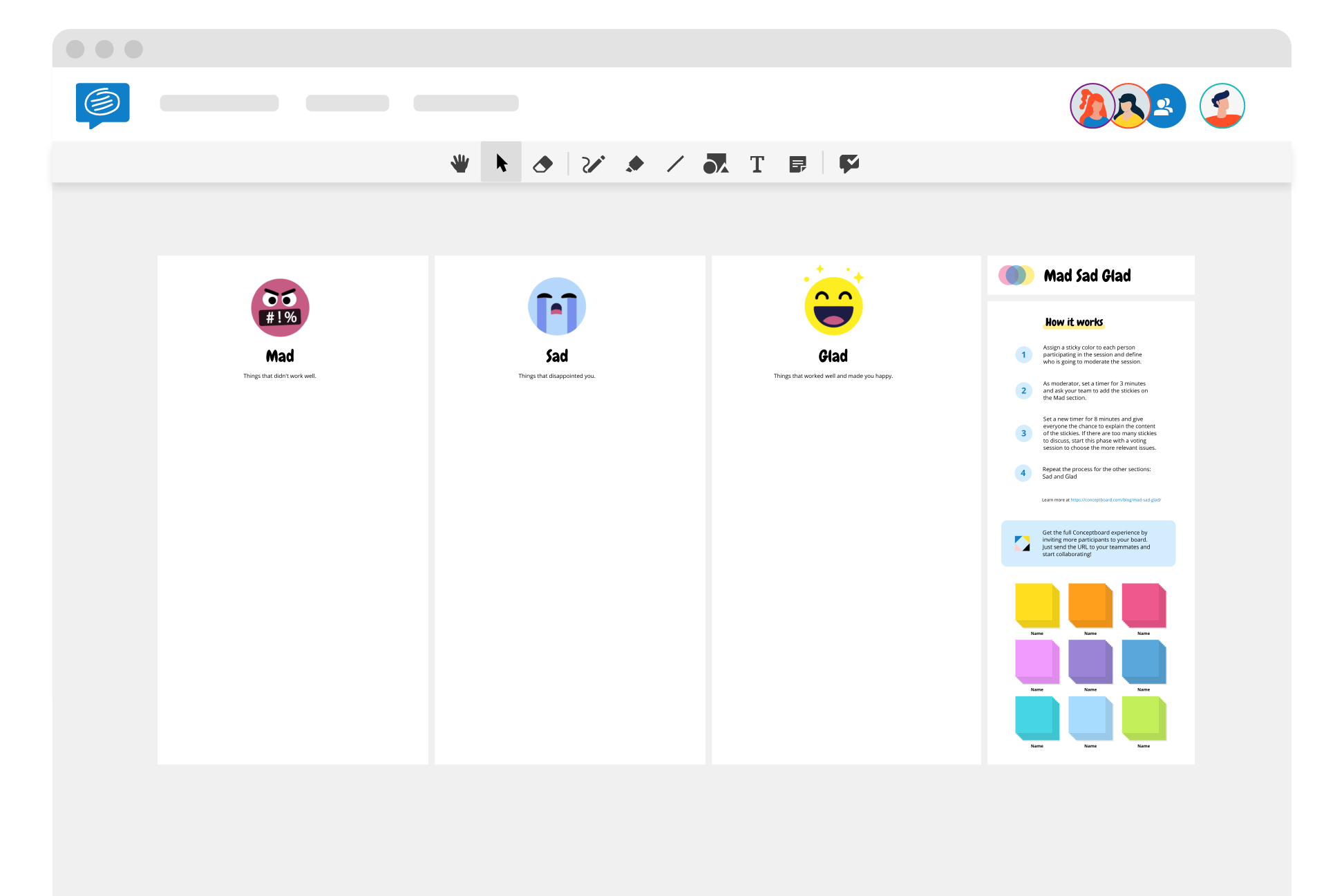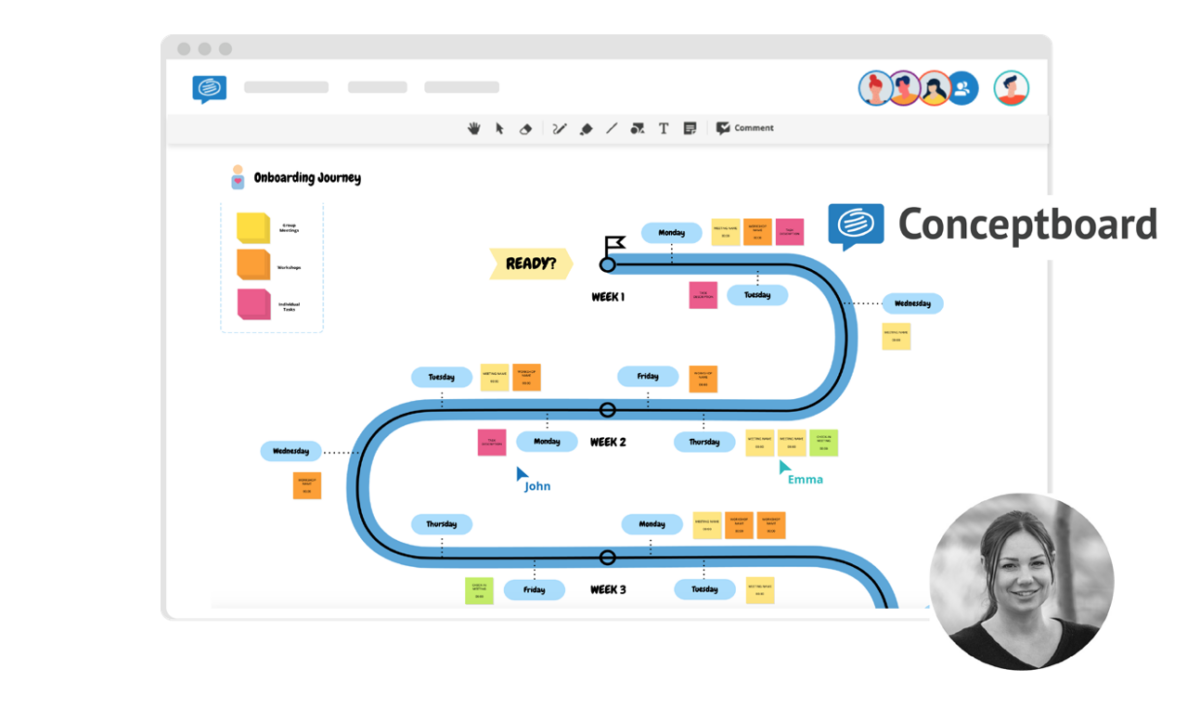A typical retrospective is all about reflecting on past performance and identifying areas of improvement. Best practices for running retrospectives include focusing on facts and avoiding letting emotions get in the way of an unbiased appraisal. The Mad Sad Glad technique takes a slightly different approach to running a retrospective. Using this technique, the team is encouraged to talk about what led to them feeling annoyed (mad), disappointed (sad) or satisfied (glad).
This focus on human emotions is what makes this retrospective technique both unique and effective when it comes to surfacing feedback and driving change. One of the easiest ways to run this technique is on an online whiteboard and a ready-made template.
Let’s dive into the different aspects of running a mad, sad, glad retrospective!
The Mad Sad Glad template
The greatest strength of the Mad, Sad, Glad retrospective lies in simplicity as well as its focus on the emotional state of team members. It provides an opportunity for open conversations which could otherwise get swept under the rug. This is what makes it a great technique when it comes to improving morale or building rapport.
As a first step in running this retrospective, we recommend pulling up this template in Conceptboard. Once you’ve inserted the template, you can see the 3 distinct sections. This template can now be filled by the participants by adding their input on online sticky notes.
The best part, these are saved automatically thanks to Conceptboard’s cloud-based functionalities.
Let’s now understand the 3 different sections of the template.
Mad: What made you feel annoyed?
This section focuses on processes that sapped productivity and led individuals to feel frustrated.
This could include anything that held back performance or team success. Use this section to highlight opportunities for improvement. What can the other members do to prevent similar feelings of annoyance in the future? What could you do better in your next sprint?
Sad: What caused feelings of disappointment?
For this section, it’s important to remember that feelings of disappointment are caused primarily when there’s a mismatch between expectations and reality. What were these expectations that were not met? How can the team help you meet these expectations in the next sprint? Chalk out a plan for how to achieve alignment on goals and expectations.
Glad: What made you happy?
Use this section to highlight everything that led to feelings of satisfaction. It could be a helpful colleague, a new task management tool or even a new vending machine in the cafeteria! This section is all about good vibes and showing love where it’s deserved! Give every member the opportunity to talk about what gets them out of bed in the morning and excited to come to work.
Steps to running a Mad Sad Glad retrospective
Now that we know about the different sections in the template, let’s take a look at how to run a Mad Sad Glad retrospective in 4 easy steps!
Step 1: Gather your team
This first step sets your retrospective up for success. Make sure all the stakeholders have been invited. Especially the decision makers. It is also good practice to assign a facilitator to moderate the session. The moderator ensures that time is allocated to discuss everyone’s feedback. He/she also keeps track of the time and guides the conversation.
Step 2: Create a space
This refers to both a physical space where the retrospective can proceed uninterrupted, as well as a metaphorical safe space for an open discussion. To make the most of the session, individuals should be aligned on the expectations in advance. The use of an online whiteboard is a great way to drive participation and democratize the conversation. It provides a perfect virtual space where everyone is free to add their ideas and not fear judgement.
Step 3: Give everyone a voice
It is the moderators’ responsibility to ensure everyone gets an equal opportunity to participate in the conversation and add their feedback. It is important that the loudest voices do not dominate the retrospective. Tackle each section of the Mad Sad Glad one by one and discuss all the feedback before moving to the next section.
Step 4: Create a plan of action
Following up on the ideas discussed, and the issues raised can make or break a retrospective. Draw up a roadmap to achieve all the action points discussed. Make sure these are both time-bound and assigned to individuals who are then held accountable. This is the only way to drive change and long-term success.
Alternatives to Mad Sad Glad
While the Mad, Sad, Glad template is great for assessing the emotional state of the team and strengthening morale, there are lots of other retrospective techniques that focus on various other aspects of reflection and analysis. Some of these classic techniques include the lessons learned or the 4Ls retrospective technique.
Additionally, the Hot Air balloon retrospective or the sailboat retrospective focus on getting members to open up through the power of visual metaphors. We’ve also rounded up a list of 11 alternative retrospective techniques you can try with your team today!





